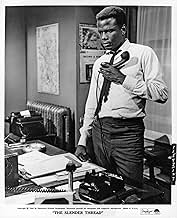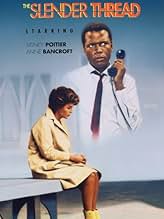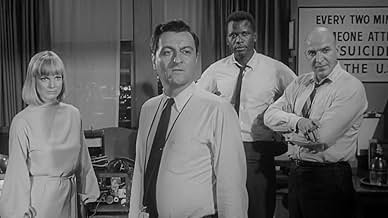Adicionar um enredo no seu idiomaCollege volunteer Alan Newell is working alone at the crisis center one evening when he receives a telephone call from suicidal caller Inga Dyson, who has swallowed a bottle of sleeping pill... Ler tudoCollege volunteer Alan Newell is working alone at the crisis center one evening when he receives a telephone call from suicidal caller Inga Dyson, who has swallowed a bottle of sleeping pills. Can Alan save her?College volunteer Alan Newell is working alone at the crisis center one evening when he receives a telephone call from suicidal caller Inga Dyson, who has swallowed a bottle of sleeping pills. Can Alan save her?
- Direção
- Roteiristas
- Artistas
- Indicado a 2 Oscars
- 2 vitórias e 4 indicações no total
- Doctor Morris
- (as H.N. Wynant)
- Patrolman Steve Peters
- (as Robert Hoy)
- Direção
- Roteiristas
- Elenco e equipe completos
- Produção, bilheteria e muito mais no IMDbPro
Avaliações em destaque
A previous reviewer said that Poitier plays his usual role: a morally superior black man in a white-dominated society. That's partly true, but here, he has a job that anyone could have, and his race doesn't really matter (although as the reviewer noted, they could have been subtly talking about race). As for Anne Bancroft, her death six months ago brings her filmography to mind. This may have not been her most famous role, but I would recommend it.
It was a terrific suspense movie that had the added benefit of showing Poitier in a totally race-neutral role as young psychology student Alan Newell who is volunteering at the local suicide hotline crisis center on a night that he has every reason to believe will be quiet...and then Inga Dyson (Ann Bancroft) calls him. She has just taken a bottle of barbiturates, does not want to be rescued, but does want to talk. So Alan has to keep his cool and keep Inga on the line long enough to be found, and she only has about 90 minutes to live.
What makes this movie totally anachronistic today is that the entire plot centers around a coordinated effort by scores of public servants in Seattle to trace Inga's phone number and save her before the pills do their job. Of course it would take about 10 seconds for the line to be traced today, which would kind of do away with the suspense.
The suspense is that her call COULD be traced, but it requires the huge telephone company building with countless thousands of connecting plugs and wires that had to be narrowed down, plus the police and fire departments and the State Department of Motor Vehicles, in order to locate the caller's number and where she was calling from. It was like a giant public works department that gave employment to pretty much every proactive player we see in the movie.
In the character development department we have a conversation between Alan an Inga in which we see how she got to the point of despair. It is one part of unforgiveness on her husband's part for a deed done before they were ever married, too much time on Inga's hands one day as the husband continues to stay emotionally detached from her as though she is some unclean thing, the fact that she wanted to talk to somebody about how she felt but could find nobody who would, and the final straw involves the death of an injured bird that is regarded callously by those around her while she tries to help.
In addition to Poitier and Bancroft, Steven Hill gives a chilling and highly credible performance as the unforgiving husband who's driven Bancroft to her suicide attempt. He's such a creepy character that he makes us almost want to force him to swallow those pills instead, and that's a sign that he plays the part to perfection.
Highly recommended because the emotions still ring true even if the technology is long gone.
Visuals aside, this is a great film. Again, dealing with some rather dark issues. The scene where Anne Bancroft comes home and sees her husband in the living room looking depressed...you don't know if he's having a psychotic episode, has lost his job or is on LSD. Anne Bancroft, overall, is a disturbing character. Perhaps more disturbing is that she would play another tragic character two years later - Mrs. Robinson, in The Graduate. Sidney Poitier is in usual form - the studious, morally-superior black in a predominantly white setting. I like what someone else here said - that the film very subtly has a subtext on race (how could a 1960s film showing blacks and whites in the same frame not? How could we as Americans not read race into the film?) while never dealing with race explicitly. This is actually one reason I think Sidney Poitier's characters and films are an important, and yet lost, representation of race relations. For all the flack that he got in the racially charged mood of the 1960s as an assimilationist good black who whites could accept, especially as he was the first black protagonist in films (it didn't help that he was West Indian, having grown up in the Bahamas). to me I still see some kind of Caribbean AND Black persona in his characters which I think he 'sneaks in' in subtle ways. His classic move is some breaking point at which he can't take any more -- whether its racial bigotry, disrespect for authority, or something else -- and he delivers some great speech of moral indignation. He does it in 'pressure point', in 'to sir with love', 'in the heat of the night', and maybe a few others. It may be pretentious at times, but this 'style' disappeared after the late 60s as blaxploitation with its overly masculinized and violent characters became the dominant representation in film.
Anyway, all the political and social analysis aside, this is really a great film.
Tech credits are first rate - scoring by Quincy Jones, costumes by Edith Head, and a Westmore on make-up. I believe this was the first directing job by Sydney Pollack - he did a nice job.
Its okay that the stars never met, they met in real life - Bancroft presented Sidney with his only Oscar, for "Lilies of the Field" two years earlier. And this would make a good double-bill with "'night, Mother", in which Bancroft is on the other end of a suicide attempt.
Você sabia?
- CuriosidadesThis film shows the tedious process in 1965 of what was required in tracing a telephone call on actual central office equipment that was state of the art such as number 5 cross bar and step-by-step electro/mechanical equipment. It was filmed in central offices of the old Northwest Bell Telephone company which as of 2010 is now Century Link. Modern telephone switching equipment can trace a call in less than a minute or even 30 seconds.
- Erros de gravaçãoAfter Inga attempts suicide by drowning herself in the bay, she arrives at hospital with perfectly styled hair.
- Citações
Mark Dyson: [to Inga] Do you think that not getting caught in a lie is the same as telling the truth?
- ConexõesFeatured in The Directors: The Films of Sydney Pollack (2000)
Principais escolhas
- How long is The Slender Thread?Fornecido pela Alexa
Detalhes
- Tempo de duração
- 1 h 38 min(98 min)
- Cor
- Mixagem de som
- Proporção
- 1.85 : 1

























